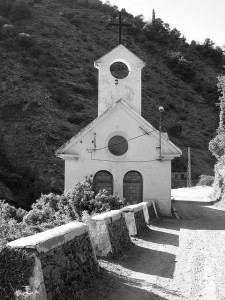 There’s an abandoned village, about 5km walk up from Capileira. It sits at the bottom of the trail that leads you up the Poqueira Valley and onwards to the Mulhacen.
There’s an abandoned village, about 5km walk up from Capileira. It sits at the bottom of the trail that leads you up the Poqueira Valley and onwards to the Mulhacen.
It’s not a particularly remote place. There is a dirt road that rises up from Caplieira and the surrounding hillsides show evidence of some low level farming.
Nevertheless, the place has been abandoned.
Looking around it, it’s hard at first to imagine what kind of fate could have befallen such a place.
True it is small, we’re talking of only a handful of houses here, but at one point it presumably harboured enough inhabitants for a little church to be built and for the road to be laid.
On the hillsides the old Arab terraces are still visible – a sign that they were still in use for cultivation not so long ago. Some of them indeed are still being worked, and scattered here and there you see the odd chestnut plantation and some cherry trees. This is fertile soil, productive soil, a place where it was, where it still is, possible to make a living from the land.
Yet still it was abandoned. As I walked around it, I tried to imagine what could have caused its decline. Why would people desert such a tranquil, fertile spot?
It was strange to wander around there. The place still had a feel to it, a strange sense that the voices of the people that once lived there could still be heard. The abandonment felt quite recent, felt, in a way, half-hearted.
It was as if the delapidation was somehow unreal. I kept waiting for some villager to appear, laden down with baskets of fruit from the orchard, and bid me good day as he passed on by.
But of course this wasn’t to be. No-one was here anymore, going about their daily lives, all there was was this. This deserted, forlorn little place, lost and left to ruin up in the hills.
Saddest of all was the little church. When I saw it, for some reason I couldn’t help but think of the people that had built it. Of their optimism at the time, the thoughts they must have had of the ceremonies they would hold there. Those sad and joyous little rituals of life. The births, the marriages, the deaths. The church spoke of a community. Not just of houses on a hill, but of a place where people had lived and died. Had celebrated and mourned.
Would they ever have imagined, I wondered, this church as it is now, lost and lonely and isolated, a place where no-one comes anymore to celebrate life. It seemed almost impossible.
I stood there with my camera, trying to imagine the terrible fate of the villagers, tying to ponder what it was that had caused this ruination. Then it dawned on me.
It was me of course! Tourists. Tourism.
Down there in Capileira and the surrounding villages, a better living was to be had, an easier living. No need to struggle on a terrace growing fruits and other crops when there was easier money to be made just a few kilometers downhill.
It made no sense, I suppose, that struggle, that old way of life. So the church was abandoned, the houses left to fall apart, the road to gather dust and accumulate potholes. The old way of life and its village was no use anymore.
It was hard to know what to think. Was this good or bad? Was this progress or the dismantling of a community? Who knows?
The only people left on the mountains now are a few resilient goat herders who stay up in the mountains for the summer grazing and pursue a lifestyle that is very old and traditional. You hear them often, yelping a sort of whistling cry to their dogs as they muster their herds to better and higher pastures. Occasionally you come across their huts, crooked rough hewn places that appear abandoned at first glance.
Closer inspection however reveals that they are still very much in use. These mountain shelters are places it seems, that will never be abandoned. Not for a long time yet at least.
One response to “Abandoned”
Hi Jen, we came across this village last week and have been trying to find out more about it. We came across a dead goat in the church doorway. Your article is great, thanks and all the best.